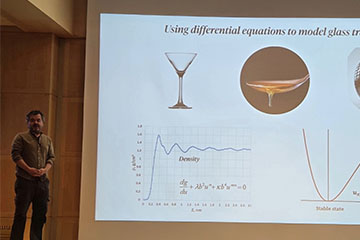What is the relationship between technology and health?
Does social media make it harder to achieve your fitness goals?

Technology, especially cell phones, helps us stay connected and provides a world of knowledge in the palm of our hands. But does it make it harder for us to achieve physical fitness?
Rick Ferkel is a member of Central Michigan University’s Physical Education and Sport faculty. He shared his expertise on how technology relates to your exercise goals.
Q: How does technology affect your ability to exercise?
If you evaluate the premise behind interactive technology (e.g., social media, video games), it all comes down to entertainment/pleasure. Overall, exercise is in direct opposition to this mindset. For some, the main reason they exercise is because they enjoy it, but for most, the pleasurable part of exercise is what it does for them mentally, cognitively and physically. That means those who consistently exercise, which is a minority at 24.2 percent (CDC, 2022), do it to stay fit and healthy to have a more productive and well-balanced life.
However, interactive technology is created with pleasure in mind. It continually triggers dopamine releases in the brain driving one to look and play more. The brain’s reactions are the same mechanisms of pulling the slot machine handle over and over with the hope of winning. It is just in a different form that reaches a much larger population. So, we are now as a society in a battle to choose between instant gratification (i.e., interactive technology) for quick pleasure with the instant dopamine release, compared to delayed gratification (i.e., exercise) with pain (i.e., work, effort, struggle). The exercise option leads to long-sustaining and beneficial pleasure.
We are now in a time where we have interactive technology/instant pleasure at all times. Because of that, it makes it harder to exercise. Not to mention, interactive technology stimulates parts of our brain that pull us more to quick stimuli while not engaging the frontal lobe of the brain that controls executive functions such as self-control and problem-solving (i.e., higher-order thinking skills). As interactive technology strengthens impulse and decreases self-control/discipline, one is less likely to have the skills to say no to unhealthy behaviors (e.g., eating sugar/junk food, hours of technology use) and to say yes to healthy behaviors (e.g., exercise, sleep, healthy eating). A snowball effect ensues that can be very difficult to get out of unless the individual decides to control behaviors to make fitness habits and realign the neural pathways in the brain. In other words, choosing to exercise in the 21st century is very difficult as most toward an option that is easier and more pleasurable.
Q: What health impacts could too much technology lead to?
Research indicates that too much technology can decrease physical activity/fitness levels, sleep and cognition (e.g., memory and focus). It also leads to increases in body weight (e.g., increased chances of obesity); poor posture; mental health issues like depression, anxiety and loneliness; and behavioral issues like moodiness and social intelligence.
I suggest reading books such as The Anxious Generation: How the Great Rewiring of Childhood is Causing an Epidemic of Mental Illness by Dr. Jonathan Haidt and Dopamine Nation: Finding Balance in the Age of Indulgence by Dr. Anna Lembke. Both of these books have a plethora of research addressing many of the issues above.
Q: Are there components of a fitness plan most at risk?
Overall, the main part of the fitness plan that is most at risk is just starting the plan. Consider an abbreviated and applicable concept from Newton’s First Law of Motion, an object remains at rest or in motion until acted upon by a force. For someone to start exercising, they have to make the choice to begin. It does not need to be long, and the intensity can vary for a multitude of reasons, but it all starts by choosing to act.
If the individual is so weighed down by the desire to be on technology, the desire to get out and exercise has to be immense. If the individual is not weighed down by the pleasure and ease of technology, the desire to exercise does not have to be as great to begin.
Exercise is planned physical activity to improve fitness. This can start small and then gradually increase, but it has to start. An individual must evaluate how much technology is blocking the ability to start. It can also be noted that many use technology as a way to help them exercise, which is a positive. If that is what someone needs to begin, then use it for good and productivity rather than a roadblock. A final comment on this topic, a main determinant of why many indicate they do not exercise is because of time. But if someone is spending 3-7 hours a day on recreational technology, time is not the issue, the prioritizing of time is.
Q: Are there forms of technology that are worse?
Social media and video games are showing the largest dopamine releases, time usage and addictive effects. The makers of both technologies have used neuroscience research to trigger the release of dopamine and other brain mechanisms to keep users engaged for long periods of time. Social media is a fairly new phenomenon of roughly 20 years old, yet think about the number of users, time, money and other resources that is now spent on it. Over the last 6,000 years it wasn’t even a consideration.
The designers of these platforms have been able to effectively use science to entice (one could even say trap) billions of people into spending hours a day on something that brings limited value to well-being while taking away many from exercise, physical activity, outdoor recreation and real human relationships. Along the same lines, the new-aged video games are well beyond the days of Pong and Pac-Man to hold the user’s attention. This includes an increase of dopamine anywhere from 75 to 300 percent. In comparison, sexual intercourse has around a 100 percent increase and cocaine has around a 250-300 percent increase in dopamine. That gives an idea of the addictive effect that video games can have.
Q: Are there ways to strike a balance between technology and exercise?
Technology is not going away and can be beneficial to help certain individuals participate, track and maintain exercise habits. However, for many, interactive technology is consuming a large amount of time and rewiring the brain to diminish the needed mechanisms to pursue exercise. This is why balance is key.
The following tips can be utilized to effectively find a healthy balance of technology use and exercise habits:
- Set time limits on the amount of recreational technology used each day. This can be tracked on your phone.
- Set a bedtime that will allow for a minimum of 7 hours of sleep; ideally 8 hours. If you struggle to sleep, shut down any interactive technology 1-2 hours before bedtime and cut out all caffeine or stop consuming caffeine before noon (max of 150 mg per day). If stopping consumption by noon still doesn’t work, incrementally bring that time back by an hour as needed.
- Set a time in the day that works best for you to exercise. For many people, the only time that is realistic to workout is in the morning due to work and/or family obligations, feeling tired at the end of the day, etc. If lunch or at night work better for you, do it - just make sure it is a time that you will commit to and make happen.
About Rick Ferkel

Rick Ferkel is a professor at Central Michigan University in the Department of Physical Education and Sport. He earned his doctorate from Texas Tech University, his master’s degree from Ashland University and his bachelor’s degree from Bowling Green State University.




